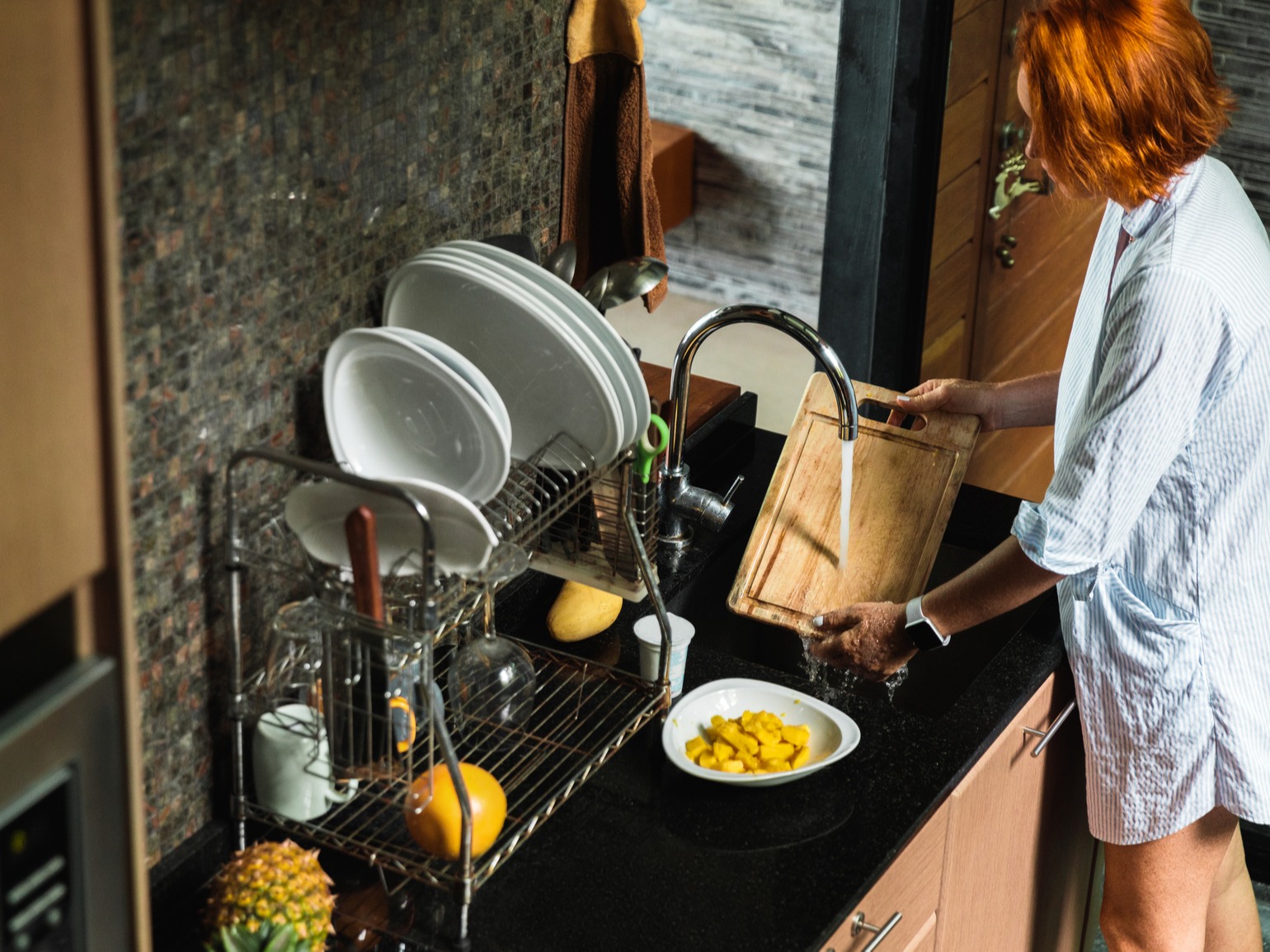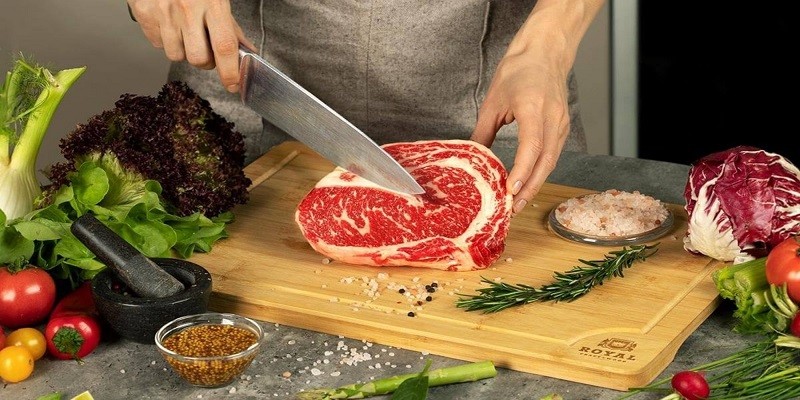Last Updated on January 15, 2025
To clean a bamboo cutting board, rinse it with hot water and mild dish soap, then wipe it dry with a clean cloth. Bamboo cutting boards are a popular choice for their durability and sustainable qualities.
They require regular cleaning to maintain their integrity and prevent the growth of bacteria. By following a simple cleaning routine, you can keep your bamboo cutting board looking and smelling fresh. We will provide you with step-by-step instructions on how to clean a bamboo cutting board effectively.
So let’s get started and ensure your cutting board remains in pristine condition for years to come.
Why Use Bamboo Cutting Boards?
Bamboo cutting boards are a popular choice due to their durability and sustainability. To clean a bamboo cutting board, simply wash it with warm soapy water and dry it thoroughly to prevent cracks and odor.
Bamboo cutting boards have gained popularity in recent years for their eco-friendly qualities and durability. If you’re wondering why you should consider using a bamboo cutting board, we’ve got you covered. In this section, we’ll explore the benefits of using bamboo cutting boards and compare them to other types of cutting boards.
Benefits Of Using Bamboo Cutting Boards:
- Sustainable material: Bamboo is a highly renewable resource that grows faster than most other plants. This makes bamboo cutting boards an eco-friendly choice compared to cutting boards made from hardwood or plastic.
- Durability: Bamboo cutting boards are known for their strength and durability. They are resistant to knife marks and warping, making them long-lasting and cost-effective in the long run.
- Easy to clean: Bamboo cutting boards are easy to clean due to their non-porous surface. Simply wash them with warm, soapy water, and dry them thoroughly to keep them in optimal condition.
- Natural antimicrobial properties: Bamboo contains a natural antimicrobial agent called bamboo kun, which helps fight against bacteria growth on the cutting board’s surface. This makes bamboo cutting boards hygienic for food preparation.
- Gentle on knives: Bamboo cutting boards are generally softer than harder materials like glass or granite. This allows knives to maintain their sharpness for longer, as the bamboo surface is less likely to dull the blades.
Comparison With Other Types Of Cutting Boards:
- Wooden cutting boards: Bamboo cutting boards offer similar benefits to traditional wooden cutting boards, such as being gentle on knives. However, bamboo is more sustainable and environmentally friendly compared to hardwood options.
- Plastic cutting boards: While plastic cutting boards are affordable and easy to maintain, they are prone to knife marks and can harbor bacteria in the grooves created by those marks. Bamboo cutting boards, on the other hand, are less prone to knife marks and have natural antimicrobial properties that keep them cleaner and more hygienic.
- Glass cutting boards: Glass cutting boards are easy to clean and provide a sturdy surface, but they are not as knife-friendly as bamboo cutting boards. Glass can quickly dull knife blades due to its hardness, making bamboo a better choice for preserving the sharpness of your kitchen knives.
Bamboo cutting boards offer numerous benefits, including sustainability, durability, ease of cleaning, natural antimicrobial properties, and knife-friendliness. When compared to other types of cutting boards, bamboo cutting boards stand out as an excellent choice for both functionality and environmental consciousness.
So why not consider adding a bamboo cutting board to your kitchen arsenal?
Cleaning Methods For Bamboo Cutting Boards
Cleaning bamboo cutting boards is a simple task. Start by wiping it down with warm soapy water, then rinse and dry thoroughly. Season it with food-grade oil regularly to maintain its quality and appearance.
Bamboo cutting boards are not only durable and eco-friendly but also require proper cleaning to maintain their longevity and hygiene. Here are three effective cleaning methods to keep your bamboo cutting board in excellent condition:
Gentle Cleaning Using Warm Soapy Water
- Use warm water and mild dish soap to create a soapy solution.
- Dip a sponge or cloth into the solution and gently scrub the surface of the cutting board.
- Pay extra attention to any food remnants or stains, ensuring they are thoroughly cleaned.
- Rinse the board with warm water to remove any soap residue.
- Dry the cutting board with a clean towel or let it air dry to prevent moisture build-up.
Removing Stains With Lemon Juice And Baking Soda
- Cut a lemon in half and squeeze the juice onto the stained area of the bamboo cutting board.
- Sprinkle a small amount of baking soda directly on the lemon juice.
- Use a soft brush or cloth to scrub the stain gently in a circular motion.
- Let the lemon juice and baking soda mixture sit on the stain for a few minutes.
- Rinse the cutting board with warm water and dry it thoroughly.
Deodorizing With Vinegar And Water Solution
- Create a mixture of equal parts water and white vinegar in a spray bottle.
- Spray the solution directly onto the bamboo cutting board.
- Let it sit for a few minutes to neutralize any odors.
- Use a clean sponge or cloth to wipe the board, ensuring that all surfaces are covered.
- Rinse the cutting board with warm water and pat it dry.
Regularly cleaning and maintaining your bamboo cutting board will not only keep it looking new but also ensure that it remains free from bacteria and odors. Remember to oil your bamboo cutting board periodically to protect it from moisture and prevent cracking.
With these cleaning methods, your bamboo cutting board will continue to serve you well in the kitchen for years to come.
Maintenance Tips For Bamboo Cutting Boards
Learn how to effectively clean and maintain your bamboo cutting board with these simple tips. Keep your board in top shape by regularly oiling it, avoiding harsh cleaners, and drying it properly after each use.
Regular oiling to prevent drying and cracking:
- Apply food-grade mineral oil to your bamboo cutting board at least once a month.
- Use a soft cloth to spread a thin layer of oil over the entire surface of the board.
- Let the oil sit for a few hours or overnight to allow it to penetrate the bamboo fibers.
- Wipe off any excess oil with a clean cloth to avoid a greasy surface.
- This regular oiling will help keep your bamboo cutting board moisturized and prevent it from drying out and cracking.
Proper drying and storage to avoid mold growth:
- After each use, wash your bamboo cutting board with warm soapy water and a sponge or dishcloth.
- Rinse the board thoroughly and pat it dry with a clean towel.
- Avoid leaving the cutting board wet or submerged in water, as this can promote mold growth.
- Stand the cutting board upright or prop it up on its side to allow air circulation and proper drying.
- Make sure the cutting board is completely dry before storing it to prevent any moisture-related issues.
Avoiding exposure to heat and direct sunlight:
- Keep your bamboo cutting board away from direct heat sources, such as stovetops and ovens.
- Avoid placing hot pots, pans, or dishes directly on the cutting board’s surface.
- Exposing bamboo to high temperatures can cause it to warp or crack.
- Additionally, avoid leaving your cutting board in direct sunlight as prolonged exposure can fade its natural color and weaken the bamboo.
By following these maintenance tips, you’ll ensure the longevity of your bamboo cutting board and keep it in excellent condition for many years to come. Remember to regularly oil your cutting board, properly dry and store it, and avoid heat and direct sunlight to prevent drying, cracking, mold growth, and other potential issues.

Credit: www.grove.co
Frequently Asked Questions For How To Clean Bamboo Cutting Board?
Do Bamboo Cutting Boards Need To Be Oiled?
Yes, bamboo cutting boards should be oiled regularly to maintain their quality and extend their lifespan.
Is Bamboo Sanitary For Cutting Boards?
Yes, bamboo cutting boards are sanitary due to their naturally antimicrobial properties.
Can You Soak A Bamboo Cutting Board In Water?
Yes, you can soak a bamboo cutting board in water for cleaning purposes.
How Do You Get Black Off A Bamboo Cutting Board?
To remove black stains from a bamboo cutting board, use a mixture of baking soda and water. Scrub gently with a brush, then rinse thoroughly.
How To Clean A Bamboo Cutting Board?
To clean a bamboo cutting board, wash it with warm soapy water and a gentle brush, then air dry it.
Conclusion
To keep your bamboo cutting board clean and prolong its lifespan, it’s crucial to follow the proper cleaning methods. Regularly wash it with warm soapy water, making sure to remove any food particles and stains. After washing, dry it thoroughly before storing it in a clean and dry place.
Avoid submerging it in water or putting it in the dishwasher, as this can cause the board to warp or crack. Applying mineral oil or beeswax regularly helps to preserve its natural beauty and prevent it from drying out. Remember to avoid using harsh chemicals or abrasive brushes that can damage the bamboo surface.
By simply incorporating these cleaning tips into your routine, your bamboo cutting board will not only stay hygienic but also maintain its aesthetic appeal. So, get started and enjoy your clean and well-maintained bamboo cutting board for years to come.




